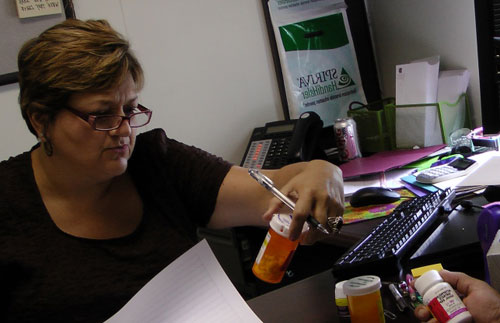Program helps elderly obtain medications at low or no cost


Older adults in the Coastal Bend can worry less about affording their medications thanks to the Texas A&M Health Science Center (TAMHSC) Coastal Bend Health Education Center’s Medication Assistance Program.
Most older individuals have at least one chronic condition and may have multiple conditions, according to the Department of Health & Human Services Administration on Aging. For these people, getting their medications is vital, but often challenging since they may have multiple prescriptions to address each condition.
“Some of these patients have up to fifteen different medications and have to alternate them on a monthly basis because they can’t afford to pay for all of them at once,” said Eslanda Trevino, outreach worker for the Coastal Bend Health Education Center Medication Assistance Program, “but we are able to find some of their medications for as low as $4.00.”
By working closely with pharmaceutical companies and retail pharmacies, the program is able to track down the lowest possible cost for medications that treat cardiovascular conditions, diabetes, respiratory conditions, Alzheimer’s, glaucoma, gastrointestinal and other disease states.
“I had a client who had six medications and was very worried about how she was going to obtain them,” said Loretta Zamora, outreach worker. “As I marked off all the medications on her list as ones we could get for her, she started crying and hugged me. What a wonderful feeling to give her such relief!”
The majority of those assisted by the program do not have insurance and/or meet federal poverty guidelines. But even those who have Medicare prescription drug coverage (Part D) can find themselves in the coverage gap and struggling to pay for prescriptions.
Also called the “donut hole,” falling into the coverage gap occurs when Medicare Part D recipients have spent their maximum allotted prescription drug costs and must pay out-of-pocket for their prescriptions until the next year or when they qualify for “catastrophic coverage” (when Medicare steps in to assist with costs). Thankfully, the Medication Assistance Program can help some of these individuals before they reach that point.
“It seems that folks reach their donut hole by the 9th or 10th month of the year,” said Naida Rios, outreach worker for the program. “So when that occurs, it becomes difficult to obtain their medications due to their limited budget. But we can determine if the pharmaceutical companies that produce their prescriptions provides assistance for patients in their situation.”
So far in 2013, the program has saved 922 people in the Coastal Bend nearly $2 million in prescription costs. This is a long way since it began in 2005 with a single administrative support person and 50 clients. Now the program spans 19 counties in the Coastal Bend and has helped more than 6,000 patients secure their medications. In 2010, the program was honored for its extraordinary outreach when it received the Presidential Award for Excellence in Community Outreach during the Texas A&M Health Science Center’s Convocation 2010.
For more information or to schedule an appointment, call toll free at 1-866-524-1408. Visit the web site to find the location nearest you.
Story contributed by Lindsey Hendrix at hendrix@tamhsc.edu or (361) 992-5905.
Media contact: media@tamu.edu
